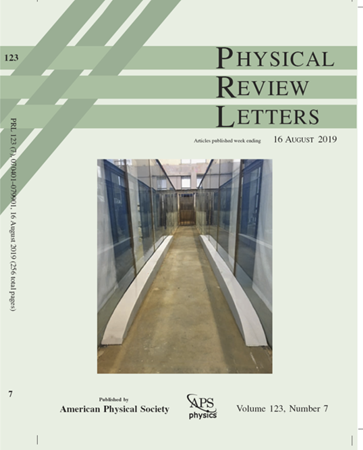Enabling Strong Neutrino Self-Interaction with an Unparticle Mediator
IF 8.1
1区 物理与天体物理
Q1 PHYSICS, MULTIDISCIPLINARY
引用次数: 0
Abstract
Recent explorations of the cosmic microwave background and the large-scale structure of the universe have indicated a preference for sizable neutrino self-interactions, much stronger than what the standard model offers. When interpreted in the context of simple particle-physics models with a light, neutrinophilic scalar mediator, some of the hints are already in tension with the combination of terrestrial, astrophysical, and cosmological constraints. We take a novel approach by considering neutrino self-interactions through a mediator with a smooth, continuous spectral density function. We consider Georgi’s unparticle with a mass gap as a concrete example and point out two useful effects for mitigating two leading constraints. (i) The Unparticle is “broadband’—it occupies a wide range of masses which allows it to pass the early universe constraint on effective number of extra neutrinos (ΔNeff) even if the mass gap lies below the MeV scale. (ii) Scattering involving unparticles is less resonant, which lifts the constraint set by IceCube based on a recent measurement of ultra-high-energy cosmogenic neutrinos. Our analysis shows that an unparticle mediator can open up ample parameter space for strong neutrino self-interactions of interest to cosmology and serves a well-motivated target for upcoming experiments.实现与非粒子介质的强中微子自相互作用
最近对宇宙微波背景和宇宙大尺度结构的探索表明,人们更倾向于大规模的中微子自相互作用,这种相互作用比标准模型提供的强得多。当在简单的粒子物理模型的背景下,用一个轻的、亲中微子的标量介质来解释时,一些暗示已经与地球、天体物理学和宇宙学的限制相结合。我们采用了一种新颖的方法,通过具有光滑连续谱密度函数的介质考虑中微子的自相互作用。我们以具有质量间隙的Georgi非粒子为具体的例子,并指出了缓解两个主要约束的两个有用的效应。(i)非粒子是“宽带”的——它占据了一个很宽的质量范围,这使得它可以通过早期宇宙对额外中微子有效数量的限制(ΔNeff),即使质量缺口低于MeV尺度。(ii)涉及非粒子的散射共振较小,这解除了冰立方基于最近对超高能量宇宙中微子的测量而设定的限制。我们的分析表明,非粒子介质可以为宇宙学感兴趣的强中微子自相互作用开辟充足的参数空间,并为即将到来的实验提供良好的动机目标。2025年由美国物理学会出版
本文章由计算机程序翻译,如有差异,请以英文原文为准。
求助全文
约1分钟内获得全文
求助全文
来源期刊

Physical review letters
物理-物理:综合
CiteScore
16.50
自引率
7.00%
发文量
2673
审稿时长
2.2 months
期刊介绍:
Physical review letters(PRL)covers the full range of applied, fundamental, and interdisciplinary physics research topics:
General physics, including statistical and quantum mechanics and quantum information
Gravitation, astrophysics, and cosmology
Elementary particles and fields
Nuclear physics
Atomic, molecular, and optical physics
Nonlinear dynamics, fluid dynamics, and classical optics
Plasma and beam physics
Condensed matter and materials physics
Polymers, soft matter, biological, climate and interdisciplinary physics, including networks
 求助内容:
求助内容: 应助结果提醒方式:
应助结果提醒方式:


